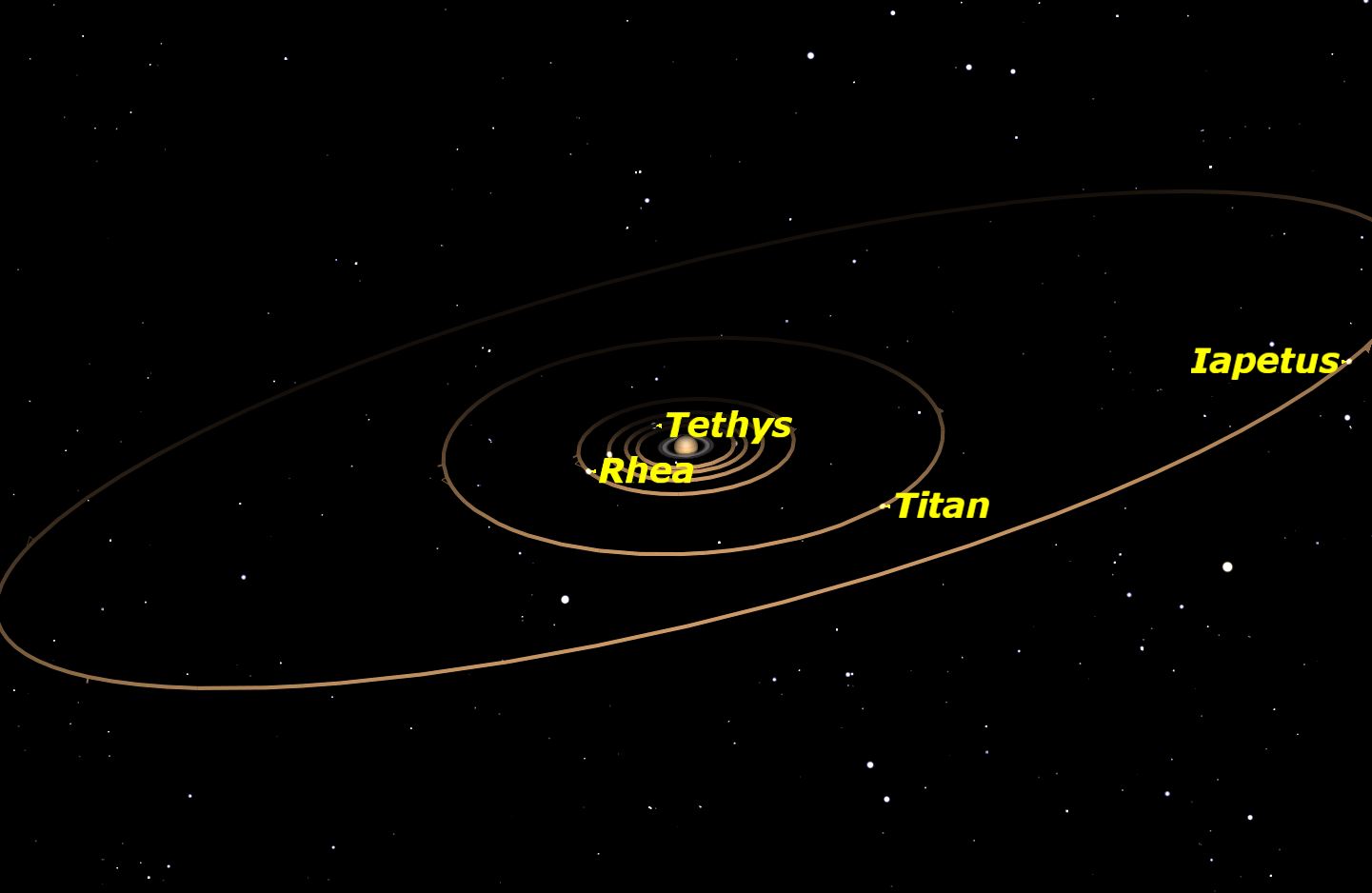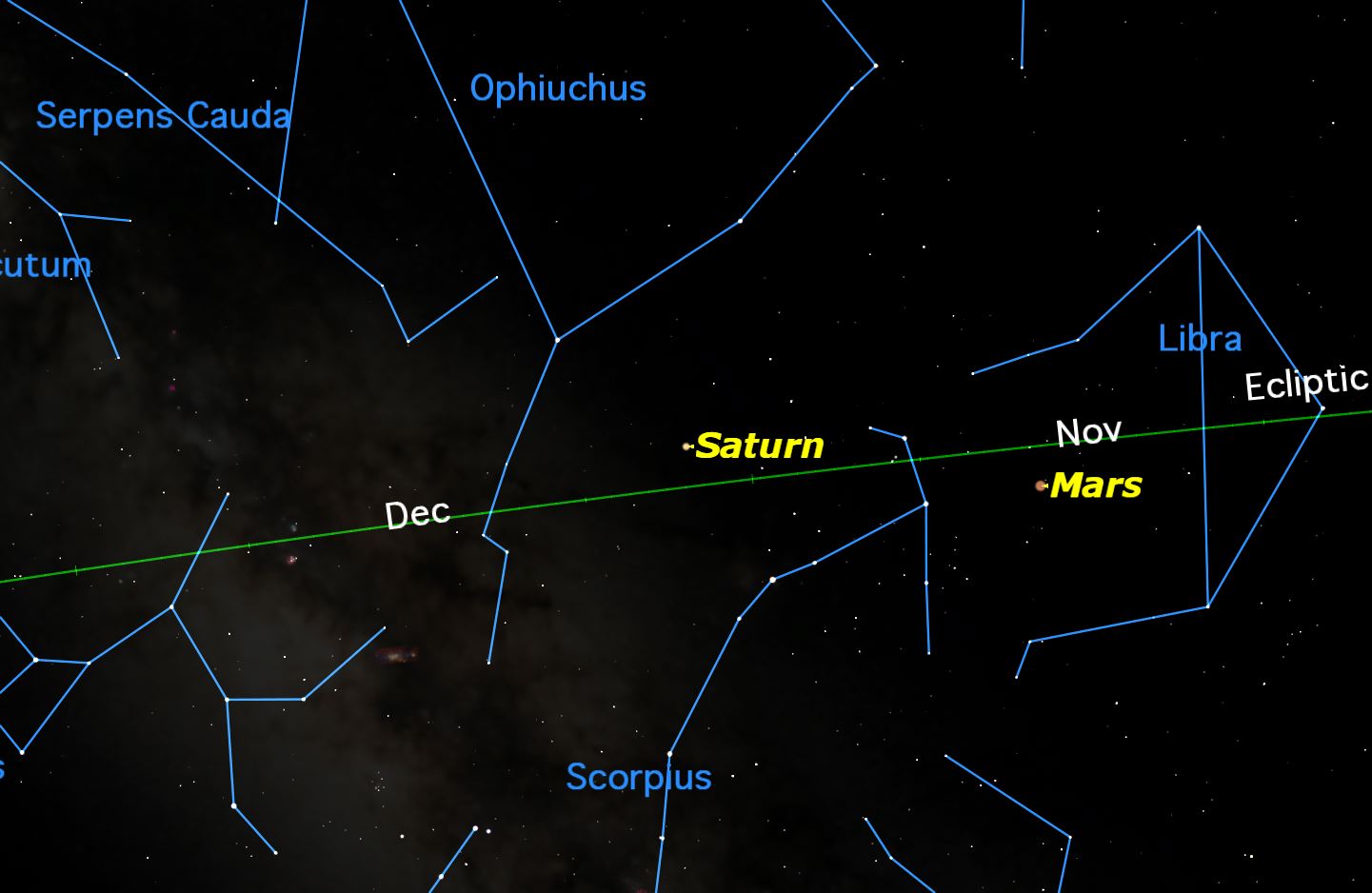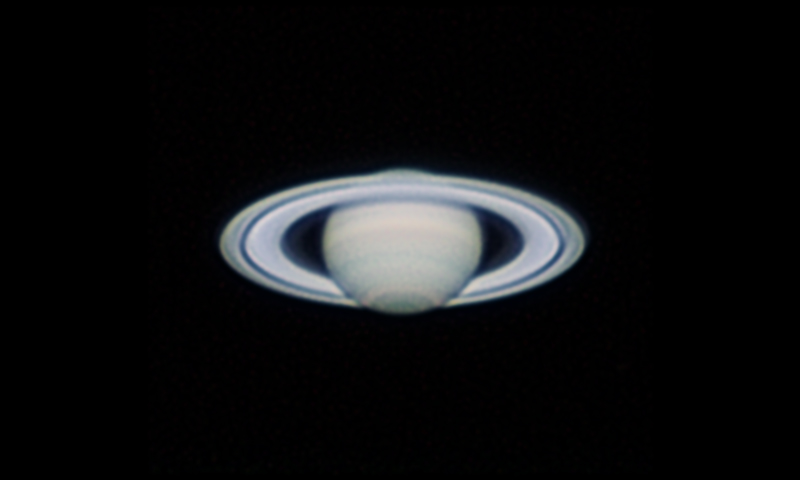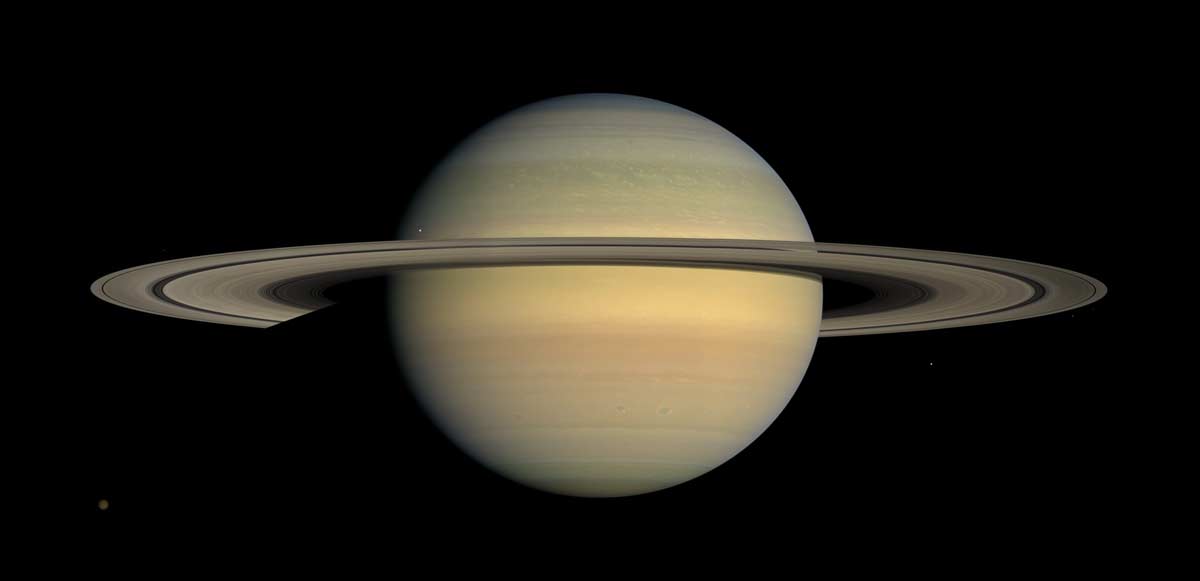Saturn Reigns Over June's Night Sky: How and When to See It

If May was "Mars month," then June certainly belongs to Saturn. Here's how to see the brightest planets in June's night sky.
Skywatchers in the Northern Hemisphere currently have three bright planets in view. All are "superior planets," strictly defined as any of the planets whose orbits are farther from the sun than Earth's. Mars is currently grabbing the headlines for its recent closest approach to Earth since 2005.
Mars takes 687 days to orbit the sun and, generally speaking, remains for approximately two months within the boundaries of each of the 12 zodiacal constellations. In comparison, Jupiter, in its 12-year orbit, advances about one constellation a year, and Saturn, in its 29-and-a-half-year orbit, takes two or three years. [Best Night Sky Events of June 2016 (Stargazing Maps)]
Currently, we can find Saturn in the nonzodiacal constellation of Ophiuchus, the Serpent Holder. It has resided there since Nov. 30, 2015, and will remain there until Feb. 23, 2017, when it will briefly cross over into Sagittarius. But as Earth's overtakes Saturn's, the planet will appear to swirl backward in a retrograde loop, returning to Ophiuchus, where it will stay until mid-November 2017 — nearly two years after it first arrived.
"Jaw-dropping experience"
On June 3, Saturn will be at opposition to the sun — exactly opposite the sun in Earth's sky — rising in the east-southeast near sunset, reaching its highest position in the southern sky (30 degrees as seen from mid-northern latitudes) in the middle of the night, and setting in the west-southwest around sunrise. Any telescope with at least 30-power magnification will show the planet's famous rings. The rings are currently tipped at nearly their greatest possible angle toward Earth and will provide a jaw-dropping experience in even a small telescope. The "Lord of the Rings" glows a golden yellow at magnitude 0.0 (where lower magnitudes appear brighter, and celestial bodies can stray into the negatives), making it almost a match for Arcturus, the fourth-brightest star in the sky. Below and to the right of Saturn is the ruddy star Antares, shining two and a half times dimmer than Saturn, while Mars beams well above and to the right of both Saturn and Antares, appearing more than five times brighter than Saturn. The trio takes on the appearance of an eye-catching isosceles triangle, with the base angles marked by Saturn and Antares and Mars at the vertex.
Saturn will be in excellent position for observation until Aug. 13, when it sinks to within 90 degrees of the sun, called east quadrature. At that point, it will be at a right angle out leftward from the sun, with its shadow most discernable on the rings behind it. In mid-October, Saturn will drop progressively closer to the sun and will become increasingly difficult to see, finally fading to invisibility within the ever-brightening evening twilight glow during the first days of November. The sun itself treads through this region of the sky in early December. Saturn will then go unseen until it struggles back into view in the morning skies of January of next year.
Rings' aspect always changes
Saturn's equator and its rings are tilted at 27 degrees to the plane of its orbit. So, there are two opposite points in the orbit, about 15 years apart, where the rings are edgewise to the sun. Saturn arrived at one of those points on Aug. 10, 2009. From now until May 6, 2025, the sun will be shining on the north face of the rings. The view from here on Earth is made more complicated because the Earth keeps oscillating its viewpoint by traveling in smaller circles around the sun. On Sept. 4, 2009, Earth passed through the plane of the rings, up to the northern side, which was its viewpoint until it crosses back on March 23, 2025.
Breaking space news, the latest updates on rocket launches, skywatching events and more!
Up until March 9 of this year, the Earth saw Saturn displaying increasingly widening rings, reaching a tilt of 26.3 degrees to our line of sight. After that, because of Earth's movement around the sun, the rings started to close up a bit and will reach an inclination of 25.9 degrees on July 28. Then, they will begin widening again, and by Dec. 28, they will be tilted 26.8 degrees in our direction, the most open they have appeared to us since May 2003.
Thus it will go on, all the way around the orbit of Saturn. The rings, as seen from the sun, will smoothly open out to a maximum on June 21, 2017. But as seen from Earth, they will flutter to both sides of the sun view with a half year periodicity, and their inclination will decrease and increase alternatively, until finally reaching their maximum of 27 degrees in October 2017. [Finest Double Stars, Bright Cluster and Planets In June 2016 (Video)]
Moons? Arms? Ears? Handles?
Galileo Galilei is sometimes credited — incorrectly — with the discovery of Saturn's rings. It is true that he was the first to point a telescope toward Saturn in July 1610, but he was completely baffled as to what he was seeing. Like Jupiter and Venus, Saturn appeared somewhat as a disk, but seemingly with a bulging shape. At first, he thought the bulges were caused by two motionless moons. He then sent another famous astronomer, Johannes Kepler, an anagram in the form of 37 letters, which, when properly solved, spelled out the Latin phrase "Altissimum planetam tergeminum observavi."
Translated into English, it reads, "I have observed the farthest planet to be triple."
Soon, viewers from Earth saw the two "moons" resembling handles or arms on Saturn's sides. These "moons" later increased in size, until they resembled two giant ears. More than two years later, however, they receded until they vanished. Then, the rings were turned nearly edgewise toward Earth and thus were difficult to see even through a large telescope.
"Has Saturn indeed swallowed its children?" Galileo asked. Saturn, after all, is the Roman equivalent of the Greek Cronus, who, in mythology, did swallow his children to keep any from growing up and overthrowing him. Galileo lamented that his mind was too weak to comprehend this strange phenomenon. In fact, his crude telescope was too weak; not until 45 years later did we learn the truth.
Mystery solved!
In 1654, a young Dutch mathematician named Christiaan Huygens, with the help of his brother Constantijn, came up with a better method of grinding and polishing glass lenses, providing greater clarity and leading to the development of a quality 50-power refracting telescope. On March 25, 1655, Christiaan Huygens t his telescope on Saturn and clearly saw the famous rings, as well as a tiny star nearby that, after several nights of observation, he determined to be a moon (which today we call Titan).
Just as Galileo did, Huygens published his discovery of Saturn's rings in the form of an anagram: "Annulo cingitur, tenui, plano, nusquam cohaerente, ad eclipticam inclinato." The English translation is, "It (the planet) is girdled by a thin, flat ring, nowhere touching, inclined to the ecliptic."
Huygens' claim went unopposed, and today, he is credited with the discovery of not only Saturn's rings but also its largest and brightest moon.
Editor's note: If you snap a stunning photo of Saturn and would like to share it with Space.com and our news partners for a possible story or image gallery, send images and comments to managing editor Tariq Malik at spacephotos@space.com.
Joe Rao serves as an instructor and guest lecturer at New York's Hayden Planetarium. He writes about astronomy for Natural History magazine, the Farmer's Almanac and other publications, and he is also an on-camera meteorologist for News 12 Westchester, New York. Follow us @Spacedotcom, Facebook and Google+. Original article on Space.com.

Joe Rao is Space.com's skywatching columnist, as well as a veteran meteorologist and eclipse chaser who also serves as an instructor and guest lecturer at New York's Hayden Planetarium. He writes about astronomy for Natural History magazine, Sky & Telescope and other publications. Joe is an 8-time Emmy-nominated meteorologist who served the Putnam Valley region of New York for over 21 years. You can find him on Twitter and YouTube tracking lunar and solar eclipses, meteor showers and more. To find out Joe's latest project, visit him on Twitter.



